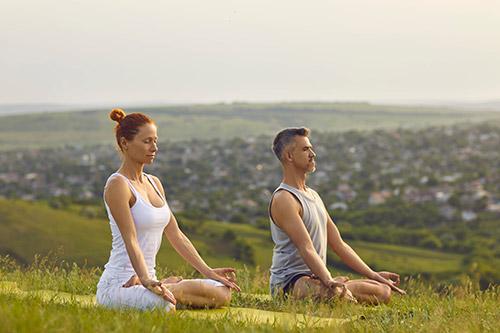The 5 myths of mindfulness - how to bring stillness to your life.
Key Article Takeaways
- You don’t need to be uncomfortable to be mindful.
- You don’t need to switch your mind off to succeed.
- Try it for at least a week with no expectations.
- You do have time, even if you think you don’t.
- You can be mindful anywhere, while doing anything.
Over time, establishing a regular mindfulness practice can lead to significant improvements in your life. It’s an effective way to improve your mental health and has proven benefits in both anxiety and depression. It can help you change your behaviour by bringing awareness to choices and providing space to choose differently. It can also improve performance in sports, particularly precision sports1. Novak Djokovic, one of the greatest tennis players of all time, uses mindfulness-based practices to help him stay focussed during his matches.
But despite the huge amounts of evidence supporting the benefits of mindfulness, many people are hesitant to try a regular mindfulness practice. Maybe you’re one of those people? Maybe because of some misconceptions you have?
Mindfulness can be a real help in today’s high-stress world. So let’s bust 5 common myths about mindfulness.
Myth number #1: “To be mindful, I need to sit uncomfortably like a monk.”
It’s common to think you need to look like you’re meditating to be mindful - sitting on the floor, back straight, crossed legs, with palms facing up and fingers together and a serene expression on your face.
This doesn’t sound at all appealing or comfortable does it? In fact, it looks and feels difficult to maintain and even painful!

When I started mindful meditation, I often found myself struggling to sit straight and with an uncomfortable pain in my lower back after the first 5 minutes. However, I wanted to do my best and kept saying mentally “Back straight. Come on…straight up. Keep it straight!!”.
This was not a restful or enjoyable experience, and I didn’t want to repeat it despite knowing all the benefits.. Everything changed when I learnt that the great thing about meditation is that you can be you and still be successful.
The most important thing to think about when choosing a posture to meditate in is that it’s comfortable. For some people that involves sitting upright without support, but for others it’s lying down, sitting on a chair or stool with your legs raised, or even reclining on a sofa.

Light Watkins, mindfulness expert and the bestselling author of “Bliss More - How to Succeed in Meditation Without Really Trying” says that “the way that you watch TV is the way that you should meditate”. You’ll have a better experience when you’re comfortable and remember to move and change position as often as you need to.
When getting ready to practise mindful meditation, reduce unnecessary physical effort and prioritise comfort - have your back supported, cushions under your knees, a blanket to keep you warm… Do it in a way that works for you and that feels good because if you like it, you’ll do it again and again!
Myth number #2: “I can’t do it - I can’t quiet my mind.”
If you think you’re failing at meditation because you can't stop thinking, I have good news - that’s normal and it’s not the point of meditation. Nobody can fully switch their minds off. Wouldn’t it be wonderful if we could? Trying to suppress thoughts or to stop your mind from thinking in meditation is going to lead to increased thoughts that you don’t want to have. Do you want to test it?
- Think about a polar bear.
- Then close your eyes and think about a polar bear for 1 minute.
- Now, close your eyes again and remember not to think about… POLAR BEARS

All right! How did that go? Did you think about something else when you were told to think of the polar bear? And did you think of the polar bear when you were told not to do it? If so, it simply means you're NORMAL.
Mindfulness is not about trying to stop thinking, it’s about learning to give yourself some distance from your thoughts. It helps you understand how your thoughts can lead to feelings and behaviours that aren’t necessarily aligned with your goals and gives you space to make a conscious choice.
Remember, if you take a moment to be mindful and find you can’t stop thinking, just observe your thoughts, see where they lead you and keep remembering, “they’re only thoughts, they’re not necessarily true”. Over time, you’ll learn to have more freedom from your thoughts.
Myth number #3: “It just doesn’t work for me.”
As you know now, success isn't about making your mind blank. It's about realising that each thought popping up is totally normal and part of the process. So then, how do we know if we’re succeeding in mindfulness practice with all these thoughts swirling around?
Mindfulness is a tool to create space for other things outside the meditation practice itself. You’re actually creating more time to invest in the experiences you're having outside this practice. The success of daily practice is becoming more adaptable in the face of challenges and enabling you to pause before rushing into action.
Think about those moments just before you say something that you might regret later or use the car horn when you’re stuck in traffic.

Many people say after trying it once or twice that mindfulness doesn’t work for them. Sound familiar? We’re used to instant results, instant gratification, same-day delivery but mindfulness is a slow burn and that’s unfamiliar to many of us.
Most people find that they start to notice changes after about a week of regular mindfulness practice. Changes can be subtle: a lift in mood, feeling more present, sleeping better, feeling less anxious, feeling more motivated and more focussed on your tasks.
Then if you stop, it may take a week or so for the effects to reduce. You may just notice you’re more cranky, feel overwhelmed, are more tired and less happy.
A great way to approach mindfulness is to drop all expectations of what you want to get out of it and just try it, regularly, for a couple of weeks. Then see how you feel. What do you notice?
Myth number #4: “I don’t have time to be mindful.”
“I don’t have time” is one of the most common reasons for us not doing things that are good for our health. The reality is we all have the same 24 hour days in the day and we choose what’s most important to us to fill that time. If you really think you can’t spare 10 minutes a day for mindfulness it might be time to look at what’s important to you and how you spend the rest of your day.
Did you know that the average adult spends around 7 hours a day glued to the screen of their phone or TV? Why not check your screen time app on your phone - how do you feel when you see how many times you pick your phone up or how many hours you’re spending on your phone?
When it comes to time and being mindful we suggest:
When to meditate?
Mindfulness practice in the morning is usually a good idea, before the business of the day takes hold. If you can manage another session in the afternoon or early evening that would be great.
How long should I meditate
Being mindful for as little as 10 minutes (or even 5) has benefits. Twice a day is ideal but if you can only manage once then that’s an excellent place to start!. Choose a time that feels realistic for you to start with and you can always sit for longer if you’re enjoying it.
How do I track the time?
Set a gentle alarm to let you know when the session is over.

Myth #5: “I have to be sat in a quiet, peaceful place to be mindful.”
For many of us, mindfulness conjures up an image of a serene space, perhaps with a candle and incense burning and maybe a statue of the Buddha. It’s true that many of the scientific studies suggest that formally sitting down to do mindful meditation is a great way to access the mind and body benefits of mindfulness. From the perspective of a scientist, it’s a lot easier to record how many minutes one is sitting in intentional practice, rather than asking people to recall how much of their day was spent in mindful awareness. The two are not the same.
Yet the reality is that many of us find a daily practice difficult to maintain and many people choose instead to bring more mindfulness directly to their daily lives.
Here are our top-tips to help you find more mindful moments:
- Bring mindfulness to making your first drink of the day. You can pay attention to the smells, sounds, movements of your body, temperature of the drink and taste.
- When you take a shower, let your senses come alive to the temperature of the water, the smell of your shampoo, the feel of your fingers through your scalp, the softness of your towel as you step out of the shower.
- When you step outside, feel the temperature of the air on your skin, take a deep breath in and see what scents you can detect on the air. Feel the sun on your face.
If you’re keen to get started and learn more about how to get started with mindfulness, check out https://franticworld.com/what-is-mindfulness/ for some free meditations and more information.
Get tips on better health
Sign up to our emails on the better way to better health.
We'll keep you up-to-date with the latest research, expert articles and new ways to get more years of better health.


